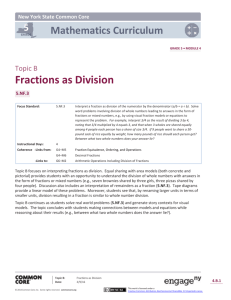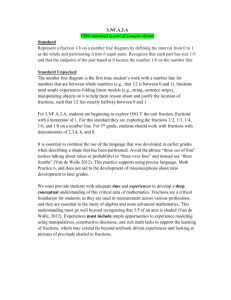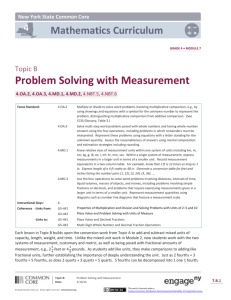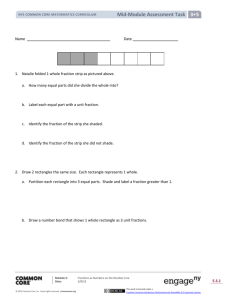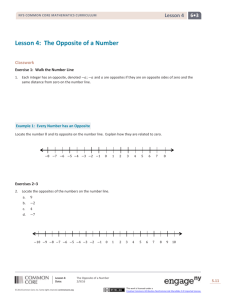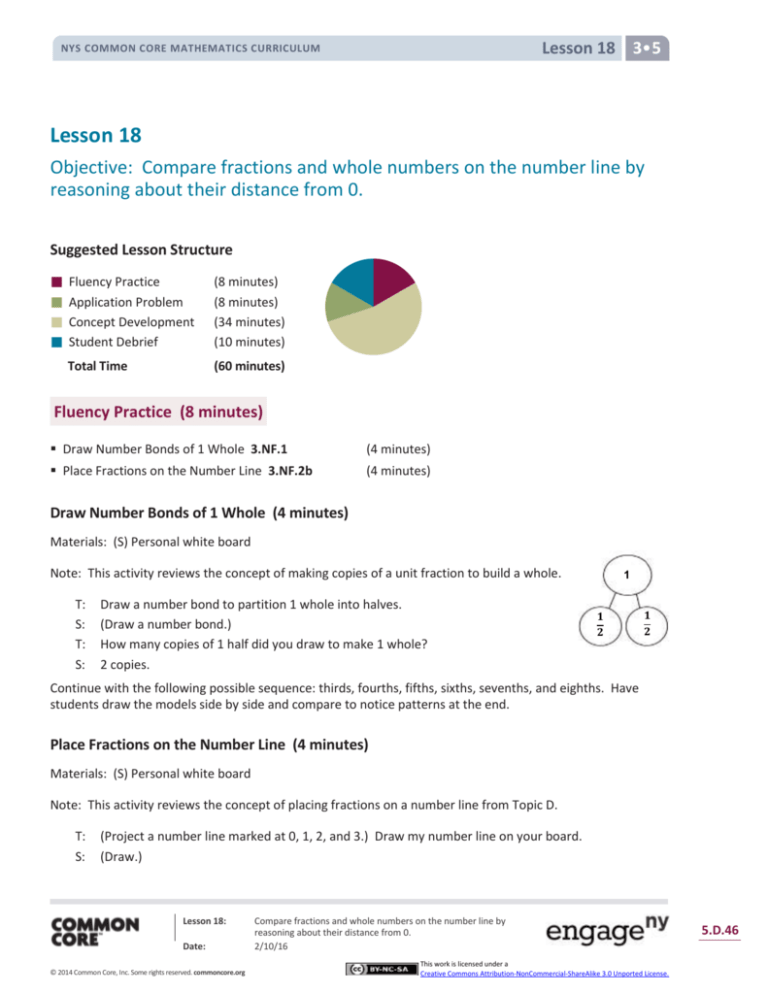
Lesson 18 3 5
NYS COMMON CORE MATHEMATICS CURRICULUM
Lesson 18
Objective: Compare fractions and whole numbers on the number line by
reasoning about their distance from 0.
Suggested Lesson Structure
Fluency Practice
Application Problem
Concept Development
Student Debrief
Total Time
(8 minutes)
(8 minutes)
(34 minutes)
(10 minutes)
(60 minutes)
Fluency Practice (8 minutes)
Draw Number Bonds of 1 Whole 3.NF.1
(4 minutes)
Place Fractions on the Number Line 3.NF.2b
(4 minutes)
Draw Number Bonds of 1 Whole (4 minutes)
Materials: (S) Personal white board
Note: This activity reviews the concept of making copies of a unit fraction to build a whole.
T:
S:
T:
S:
Draw a number bond to partition 1 whole into halves.
(Draw a number bond.)
How many copies of 1 half did you draw to make 1 whole?
2 copies.
1
𝟏
𝟐
𝟏
𝟐
Continue with the following possible sequence: thirds, fourths, fifths, sixths, sevenths, and eighths. Have
students draw the models side by side and compare to notice patterns at the end.
Place Fractions on the Number Line (4 minutes)
Materials: (S) Personal white board
Note: This activity reviews the concept of placing fractions on a number line from Topic D.
T:
S:
(Project a number line marked at 0, 1, 2, and 3.) Draw my number line on your board.
(Draw.)
Lesson 18:
Date:
© 2014 Common Core, Inc. Some rights reserved. commoncore.org
Compare fractions and whole numbers on the number line by
reasoning about their distance from 0.
2/10/16
This work is licensed under a
Creative Commons Attribution-NonCommercial-ShareAlike 3.0 Unported License.
5.D.46
Lesson 18 3 5
NYS COMMON CORE MATHEMATICS CURRICULUM
T:
Estimate to mark and label 1 third in the interval 0 to 1.
S:
(Estimate the point between 0 and 1 and write 3.)
T:
Write 3 thirds on your number line. Label the point as a fraction.
S:
(Write above the 1 on the number line.)
1
3
3
6 9 4 7 2
8
Continue with the following possible sequence: 3, 3, 3, 3, 3, and 3.
Application Problem (8 minutes)
Third grade students are growing peppers. The student with the longest pepper wins the Green Thumb
10
MP.2 award. Jackson’s pepper measured 3 inches long. Drew’s measured 4 inches long. Who won the award?
Draw a number line to help prove your answer.
Note: This problem reviews the concept of placing fractions on a number line from Topic D. It is also used
during the Concept Development to discuss a fraction’s distance from 0.
Concept Development (34 minutes)
Materials: (T) Large-scale number line partitioned into thirds (description below), 4 containers, 4 beanbags
(or balled-up pieces of paper), sticky notes (S) Work from Application Problem
T:
T:
S:
Look at the number line I’ve created on the floor. Let’s
use it to measure and compare.
This number line shows the interval from 0 to 1. (Place
sticky notes with 0 and 1 written on them in the
appropriate places.) What fractional unit does the
number line show?
Thirds.
1
NOTE ON
MATERIALS:
Before the lesson, use masking tape to
make a large-scale number line from 0
to 1 on the floor or in the hallway.
Partition the interval evenly into thirds.
Try to make the 0 and 1 far apart.
2
T:
Let’s place containers on 3 and 3. (Select volunteers to
place containers.)
S:
(Place containers.)
T:
How can we use our thirds to help us place 6 on this number line?
S:
1
6
1
1
is right in the middle of the first third. (Place a container on 6.)
Lesson 18:
Date:
© 2014 Common Core, Inc. Some rights reserved. commoncore.org
Compare fractions and whole numbers on the number line by
reasoning about their distance from 0.
2/10/16
This work is licensed under a
Creative Commons Attribution-NonCommercial-ShareAlike 3.0 Unported License.
5.D.47
Lesson 18 3 5
NYS COMMON CORE MATHEMATICS CURRICULUM
T:
S:
T:
S:
T:
Looking at the number line, where can we place our
last container so that it is the greatest distance from 0?
NOTES ON
On 1. On this number line, it has to be 1 because
MULTIPLE MEANS
the interval is from 0 to 1. 1 is the farthest point
OF REPRESENTATION:
from 0 on this number line. (Place a container on 1.)
You may want to preteach vocabulary
Suppose we invite 4 volunteers to come up. Each
by adding it to a math word wall before
volunteer takes a turn to stand at 0 and toss a beanbag
the lesson starts. Helping students
connect terms such as more than,
into one of the containers. Which container will be the
fewer, and the same to familiar
hardest, and which will be the easiest to toss the
symbols or words used often (greater
beanbag into? Why?
than, less than, equal to) will make the
The container at 1 will be the hardest because it’s the
language more accessible during the
1
lesson.
farthest away from 0. The container at will be
6
easy. It’s close to 0.
Let’s have volunteers toss. (Each volunteer tosses a beanbag into a given container. They toss the
1 1 2
following in order: , , , and 1 whole.)
6 3 3
S:
(Volunteers toss while others observe.)
Guide students to discuss how each toss shows the different distances from 0 that each beanbag traveled.
Emphasize the distance from 0 as an important feature of the comparison.
T:
S:
T:
S:
T:
S:
Why is a fraction’s distance from 0 important for comparison?
(Discuss.)
How would the comparison change if each volunteer stood at a different place on the number line?
It would be hard to compare because distances would be different. The distance the beanbag flew
wouldn’t tell you how big the fraction is. It’s like measuring. When you use a ruler, you start at 0
to measure. Then you can compare the measurements. The number line is like a giant ruler.
Suppose we tossed beanbags to containers at the same points from 0 to 1 on a different number line,
but the distance from 0 to 1 was different. How would the comparison of the fractions change if the
distance from 0 to 1 was shorter? Longer?
If the whole changes, the distance between fractions also changes. So, if the number line was
shorter, then the distance to toss each beanbag would also be shorter. If the number line was
longer, then the distance to toss each beanbag would also be longer. True, but the position of
each fraction within the number lines stays the same. So, the comparisons would be the same,
but the distance between 0 and each fraction would change.
Students return to their seats.
T:
S:
T:
Think back to our Application Problem. What in the Application Problem relates to the length of the
toss?
How big the peppers are. The length of the peppers.
Talk to your partner. How did we use the distance from 0 to show the length of the peppers?
Lesson 18:
Date:
© 2014 Common Core, Inc. Some rights reserved. commoncore.org
Compare fractions and whole numbers on the number line by
reasoning about their distance from 0.
2/10/16
This work is licensed under a
Creative Commons Attribution-NonCommercial-ShareAlike 3.0 Unported License.
5.D.48
Lesson 18 3 5
NYS COMMON CORE MATHEMATICS CURRICULUM
S:
10
We saw 3 is larger than 4 . We used the number line sort of like a ruler. We put the
measurements on it. Then, we saw which one was farthest from the 0. On the number line, you
10
can see that the length from 0 to 3 is longer than the length from 0 to .
4
T:
S:
Let’s do the same thing we did with our big number
line on the floor, pretending we measured giant
peppers with yards instead of inches. 1 pepper
10
measured 3 yards long, and the other measured 4
yards. How would the comparison of the fractions
change using yards rather than inches?
Yards are much larger than inches. But even though
10
the measurement units changed, 4 yards is still less
than 3 yards, just like
10
4
inches is less than 3 inches.
NOTES ON
MULTIPLE MEANS
OF ENGAGEMENT:
As students compare the giant
peppers, a third pepper can be given to
them to include in the comparison. If
preferred, the length of the pepper can
12
be equal to .
4
Problem Set (10 minutes)
Students should do their personal best to complete the
Problem Set within the allotted 10 minutes. For some
classes, it may be appropriate to modify the assignment by
specifying which problems they work on first. Some
problems do not specify a method for solving. Students
should solve these problems using the RDW approach
used for Application Problems.
Student Debrief (10 minutes)
Lesson Objective: Compare fractions and whole numbers
on the number line by reasoning about their distance from
0.
The Student Debrief is intended to invite reflection and
active processing of the total lesson experience.
Invite students to review their solutions for the Problem
Set. They should check work by comparing answers with a
partner before going over answers as a class. Look for
misconceptions or misunderstandings that can be addressed in the Debrief. Guide students in a conversation
to debrief the Problem Set and process the lesson.
Any combination of the questions below may be used to lead
the discussion.
If necessary, review the toss portion of the lesson by having students draw each toss on a separate
number line, and then place the fractions on the same number line to compare.
Lesson 18:
Date:
© 2014 Common Core, Inc. Some rights reserved. commoncore.org
Compare fractions and whole numbers on the number line by
reasoning about their distance from 0.
2/10/16
This work is licensed under a
Creative Commons Attribution-NonCommercial-ShareAlike 3.0 Unported License.
5.D.49
Lesson 18 3 5
NYS COMMON CORE MATHEMATICS CURRICULUM
Invite students to share their work on
Problems 6–8. Ensure that each student can
articulate how the distance from 0 helped them
figure out which fraction was greater or less.
Extend the lesson by having students work
through the same comparison given at the end of
the Concept Development, this time altering the
measurements to centimeters and inches.
Exit Ticket (3 minutes)
After the Student Debrief, instruct students to complete
the Exit Ticket. A review of their work will help with
assessing students’ understanding of the concepts that
were presented in today’s lesson and planning more
effectively for future lessons. The questions may be read
aloud to the students.
Lesson 18:
Date:
© 2014 Common Core, Inc. Some rights reserved. commoncore.org
Compare fractions and whole numbers on the number line by
reasoning about their distance from 0.
2/10/16
This work is licensed under a
Creative Commons Attribution-NonCommercial-ShareAlike 3.0 Unported License.
5.D.50
Lesson 18 Problem Set
NYS COMMON CORE MATHEMATICS CURRICULUM
Name
Date
Place the two fractions on the number line. Circle the fraction with the distance closest to 0. Then, compare
using >, <, or =. The first problem is done for you.
0
4
1.
2.
3.
4.
5.
1
4
2
6
1
2
2
3
11
8
<
1
4
2
4
3
4
4
4
3
4
0
1
0
1
0
1
0
1
1
2
3
6
1
4
2
6
7
4
Lesson 18:
Date:
© 2014 Common Core, Inc. Some rights reserved. commoncore.org
Compare fractions and whole numbers on the number line by
reasoning about their distance from 0.
2/10/16
This work is licensed under a
Creative Commons Attribution-NonCommercial-ShareAlike 3.0 Unported License.
5.D.51
Lesson 18 Problem Set
NYS COMMON CORE MATHEMATICS CURRICULUM
5
6
7
8
6. JoAnn and Lupe live straight down the street from their school. JoAnn walks mile and Lupe walks mile
home from school every day. Draw a number line to model how far each girl walks. Who walks the least?
Explain how you know using pictures, numbers, and words.
5
4
4
5
7. Cheryl cuts 2 pieces of thread. The blue thread is meters long. The red thread is meters long. Draw a
number line to model the length of each piece of thread. Which piece of thread is shorter? Explain how
you know using pictures, numbers, and words.
7
7
8. Brandon makes homemade spaghetti. He measures 3 noodles. One measures 8 feet, the second is 4 feet,
4
and the third is 2 feet long. Draw a number line to model the length of each piece of spaghetti. Write a
number sentence using <, >, or = to compare the pieces. Explain using pictures, numbers, and words.
Lesson 18:
Date:
© 2014 Common Core, Inc. Some rights reserved. commoncore.org
Compare fractions and whole numbers on the number line by
reasoning about their distance from 0.
2/10/16
This work is licensed under a
Creative Commons Attribution-NonCommercial-ShareAlike 3.0 Unported License.
5.D.52
Lesson 18 Exit Ticket
NYS COMMON CORE MATHEMATICS CURRICULUM
Name
Date
Place the two fractions on the number line. Circle the fraction with the distance closest to 0. Then, compare
using >, <, or =.
1.
2.
3
5
1
2
1
5
0
1
0
1
3
4
2
3
3. Mr. Brady draws a fraction on the board. Ken says it’s 3, and Dan said it’s 2. Do both of these fractions
2
3
mean the same thing? If not, which fraction is larger? Draw a number line to model 3 and 2. Use words,
pictures, and numbers to explain your comparison.
Lesson 18:
Date:
© 2014 Common Core, Inc. Some rights reserved. commoncore.org
Compare fractions and whole numbers on the number line by
reasoning about their distance from 0.
2/10/16
This work is licensed under a
Creative Commons Attribution-NonCommercial-ShareAlike 3.0 Unported License.
5.D.53
NYS COMMON CORE MATHEMATICS CURRICULUM
Name
Lesson 18 Homework
Date
Place the two fractions on the number line. Circle the fraction with the distance closest to 0. Then, compare
using >, <, or =.
1.
2.
3.
4.
5.
1
3
4
6
1
4
4
5
8
6
2
3
0
1
0
1
0
1
0
1
1
2
1
6
1
8
4
10
5
3
Lesson 18:
Date:
© 2014 Common Core, Inc. Some rights reserved. commoncore.org
Compare fractions and whole numbers on the number line by
reasoning about their distance from 0.
2/10/16
This work is licensed under a
Creative Commons Attribution-NonCommercial-ShareAlike 3.0 Unported License.
5.D.54
Lesson 18 Homework
NYS COMMON CORE MATHEMATICS CURRICULUM
4
6
5
7
6. Liz and Jay each have a piece of string. Liz’s string is yard long, and Jay’s string is yard long. Whose
string is longer? Draw a number line to model the length of both strings. Explain the comparison using
pictures, numbers, and words.
7. In a long jump competition, Wendy jumped
9
10
meter, and Judy jumped
10
9
meter. Draw a number line to
model the distance of each girl’s long jump. Who jumped the shorter distance? Explain how you know
using pictures, numbers, and words.
5
5
8. Nikki has 3 pieces of yarn. The first piece is 6 feet long, the second piece is 3 feet long, and the third piece
3
2
is feet long. She wants to arrange them from the shortest to the longest. Draw a number line to model
the length of each piece of yarn. Write a number sentence using <, >, or = to compare the pieces. Explain
using pictures, numbers, and words.
Lesson 18:
Date:
© 2014 Common Core, Inc. Some rights reserved. commoncore.org
Compare fractions and whole numbers on the number line by
reasoning about their distance from 0.
2/10/16
This work is licensed under a
Creative Commons Attribution-NonCommercial-ShareAlike 3.0 Unported License.
5.D.55


